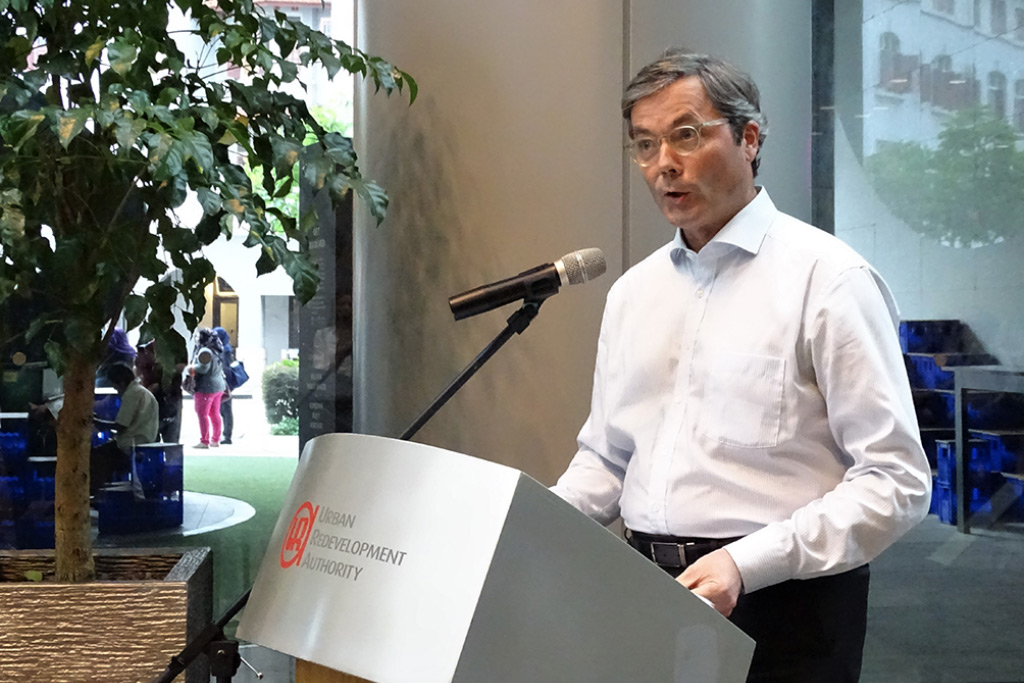
Greeting by the German Ambassador to Singapore, Dr. Ulrich A. Sante, at the opening of the exhibition Housing Modernities.
Ladies and gentlemen,
This year, we celebrate the 100th birthday of Bauhaus. When the Bundestag, the German Federal Parliament, debated the anniversary celebrations nearly five years ago, nobody imagined that the 2019 Bauhaus anniversary would be such a great success. One could say: “Bauhaus everywhere!” with more than 2,000 events throughout the whole country. My wife and I even planned this year’s summer holiday around Bauhaus and invited our four kids to spend some days in Weimar and its beautiful surroundings with us – yes, with some extended hikes through the mountains and forests of Thüringen and a round of golf, but mainly concentrating on how Bauhaus influenced my country and over time the globe through its very holistic approach to basic needs in life!
The major international exhibition tour bauhaus imaginista was on show in Berlin earlier this year and impressively demonstrated the worldwide networking of the Bauhaus. Thanks to the efforts of Goethe-Institut Singapore and Objectifs, we welcomed the exhibition looking at Southeast Asia just a few days ago here in Singapore.
In Weimar and Dessau, the long-awaited Bauhaus Museums were finally opened – attracting from the start hundreds of thousands of visitors. I invite you all to join not only the exhibition at Objectifs, but also to make Bauhaus one of your reasons to travel to Germany and relive this cultural awakening during the years in between the two great wars, which represents one of the most important and successful cultural exports of Germany in the 20th century. At the same time, the anniversary organizers were very clear from the outset that the year is not intended as an uncritical celebration. Its intention is rather to locate the Bauhaus in the critical field of tension of modernity – with all its positive and negative aspects.
The ideas and design approaches for a modern, open, and free society are the heart of what Bauhaus embodied from the start. These ideas served as guiding principles for reconstruction and new beginnings in West Germany after World War II. Bauhaus’s ideas continue to stand for a Germany that is open to the world and willing to engage in dialogue.
As heirs to this modern cultural heritage, Germany considers it its responsibility to preserve these ideas and present platforms to discuss the relevance that the Bauhaus philosophy continues to offer to today’s world. It is in this spirit that the German Federal Foreign Office, with the support of the German Bundestag, has decided to support the project Encounters with South East Asian Modernism.
As in Germany, the mid-20th century also marked the start of a new era in many countries of Southeast Asia. Encounters with South East Asian Modernism – with its stop-overs in Phnom Penh, Jakarta, Yangon, and now Singapore after its initial start in Berlin in Summer this year – intends to look at how the architectural language of international modernism helped these young states in their efforts and desire to express their new beginning, establish themselves as new nations, and define their own identity, not least – and that’s our focus here – through the use of architecture and urban planning.
By being part of this broader project, the exhibition we open today — and which has been carefully prepared by Dean Ho Puay-Peng – is part of the steps beyond simply celebrating 100 years of Bauhaus: it takes a different perspective on how architecture and local modernisms reflect hopes of progress and prosperity, sometimes also with the intention to signal emancipation from former colonial rule.
It goes without saying that this story cannot be told in Singapore without looking at public housing and its role in nation-building. The dialogue we start with today’s exhibition will be continued this Saturday, when the threads of the projects developed in parallel in Cambodia, Indonesia, and Myanmar are woven into the discussion and the lively ongoing regional discourse at a symposium at the NTU Centre of Contemporary Arts, which will also sum up and conclude the string of exhibits with the question: What can we learn from modernism today?
And as the exhibition at Objectifs also offers a chance to put Jeremy San’s photographic masterworks on display to make us relive and appreciate Singapore’s modern heritage – much of which has unfortunately been lost already – I would like to add the question: Is it worth, and what is worth, being preserved by us among those architectural works that once embodied the dawn of a new age? And if there is something that merits preservation, how can we go about it? Which themes and works of architects – and I am sure there are many – should be made known and better heard in Europe and elsewhere in the world to again be developed further?
In closing, let me ask all of you who have participated in this project in the past weeks, or who will participate in the upcoming days, to keep an open mind and to carry forth and continue to develop the philosophy of Bauhaus – or I should rather say the philosophy that has continued to build on Bauhaus-ideas – into the 21st century. Even if Bauhaus made its start from Germany, its ideas now belong to the world and it is upon us to let its ideas live on in the 21st century.
Walter Gropius once said: “The mind is like an umbrella – it functions best when it is open.” So let your minds be umbrellas! Not as a means of protection; just the opposite!
